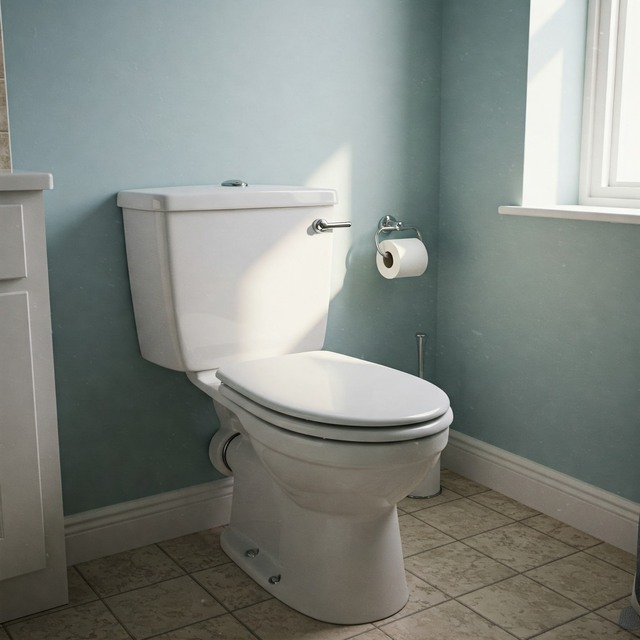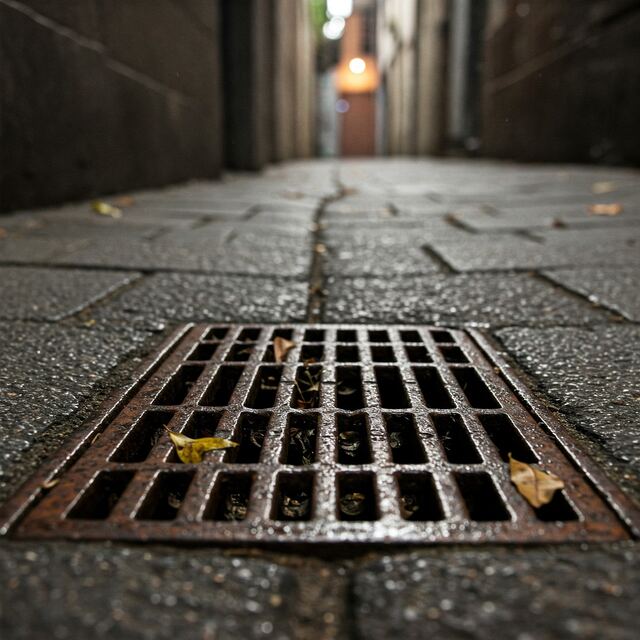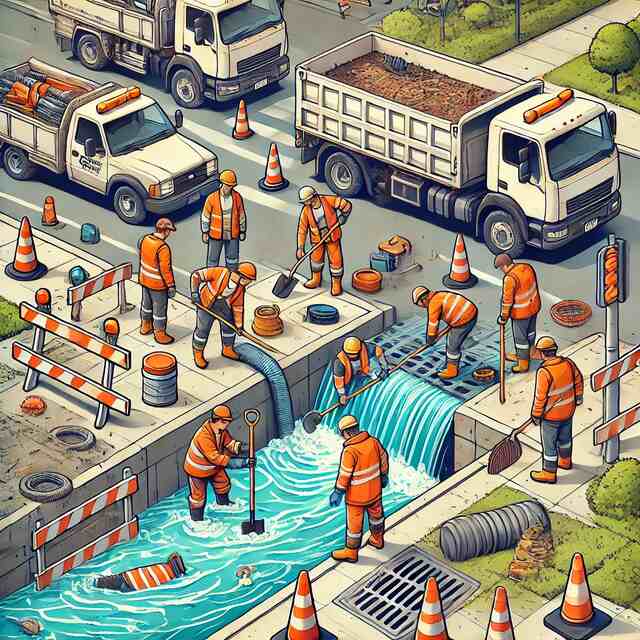What starts as a small nuisance can become a major headache with blocked drains. This is especially true when the weather turns bad.
For more details see our main main service page.
Frequent Causes of Blocked Drains in Swillington
Like other places, drainage systems in Swillington, can encounter many different kinds of blockages, similar to other locations, usually stemming from daily habits. The main causes include:
Fat, Oil, and Grease Buildup
Grease, fat, and oil commonly cause blockages in kitchen drains. These substances can solidify in pipes when they cool, causing water to drain more slowly over time.
As it accumulates, it may fully block the drain and cause water to overflow. In Swillington, this is particularly common in takeaway establishments.
Hair Buildup and Soap Residue
Bathroom drainage issues are often due to hair and soap residue clogging the drains.
Over time, this buildup restricts water flow, causing slow or standing water.
Non-Flushable Items
Things like wipes, toys, or sanitary products can cause serious pipe blockages.
These objects do not dissolve like toilet paper, resulting in large blockages.
Outdoor Debris and Roots
Roots seeking water and seasonal debris often block outdoor drains in Swillington. Such issues can cause major blockages, particularly during heavy rain.
Symptoms of a Blocked Drain
If you’re experiencing any of the following issues, it may be time to contact a drain unblocking service in Swillington:
Water Drains Slowly
If water is slow to drain from your sinks or showers, a blockage may be forming.
Bad Smells
Unpleasant odours from drains are often linked to a blockage caused by trapped waste.
Unusual Water Noises
Unusual noises from drains indicate air is escaping past a blockage.
Stagnant Water and Overflowing Drains
Water pooling or drains overflowing can mean a serious drainage issue.

Local Drain Unblocking Services in Swillington
Calling a professional is usually the fastest solution for a blocked drain. After checking with Swillington council and Leeds City Council, it might be time to call a professional.
Using High-Pressure Jets
One of the most effective methods for clearing blocked drains is high-pressure water jetting. This involves blasting water at high speed through the pipes to dislodge and clear away blockages caused by grease, debris, or tree roots.
This method is both thorough and environmentally friendly, as it doesn’t rely on chemicals.
Drain Augers and Snakes
For smaller or more localised blockages, a drain snake or auger may be used. These tools are flexible and break up clogs from hair, soap, or objects.
CCTV Drain Surveys
CCTV drain inspections are used when blockages are hard to detect.
It involves a camera being inserted into the drain to pinpoint the issue.
Fixing Blocked Drains
A broken or collapsed pipe may be causing the blockage. These services restore the system to good working condition.

Swillington: A Historic Village with Essential Drainage Needs
Swillington, a village located five miles east of Leeds city centre, has grown from its coal-mining roots into a thriving residential community.
Surrounded by green spaces like St Aidan’s Nature Reserve and the River Aire, it offers a peaceful rural atmosphere while maintaining close ties to the city.
However, as with many older settlements, Swillington faces drainage challenges that require proper attention to avoid issues like flooding and blockages.
Common Drainage Issues in Swillington
With a combination of historic and modern properties, drainage concerns in Swillington often include:
- Blocked drains due to improper waste disposal, including wet wipes, grease, and sanitary products.
- Tree root intrusion into aging underground pipes, leading to blockages or structural damage.
- Heavy rainfall increasing the risk of localised flooding and water pooling, particularly in lower-lying areas.
If these problems are not addressed in time, they can lead to slow-draining water, foul odours, and potential property damage.
Local Drainage Solutions in Swillington
To prevent drainage issues, residents in Swillington can take a few key steps:
- Dispose of waste correctly by avoiding flushing non-biodegradable items and keeping fats, oils, and grease out of sinks.
- Regularly clear outdoor drains and gutters to prevent leaves and debris from causing blockages.
- Monitor for early signs of drainage issues, such as slow water flow or bad smells, and take action before the problem worsens.
For larger drainage concerns beyond private properties, residents should contact:
- Yorkshire Water, which manages public sewer maintenance and major drainage infrastructure.
- Leeds City Council, responsible for maintaining road drains and offering support for local flooding concerns.
Why Proper Drainage Maintenance Matters in Swillington
A well-maintained drainage system ensures that homes, businesses, and roads in Swillington remain safe from avoidable water damage and costly repairs.
By being proactive and using local resources, residents can keep drainage systems running efficiently and prevent future disruptions.
For professional support with blocked drains or drainage maintenance in Swillington, Yorkshire Water and Leeds City Council offer services to help manage and resolve drainage issues efficiently.

Who Is Responsible for Unblocking Your Drain in Swillington: Tenant, Landlord, or Local Council?
In Swillington, as in other parts of Leeds, drainage issues can arise due to various factors, and determining responsibility depends on the cause and location of the blockage.
Whether it falls on the tenant, landlord, or local council, understanding these roles ensures that drainage problems are resolved efficiently.
Tenant Responsibility
Tenants in Swillington are generally responsible for unblocking drains if the issue is caused by misuse or improper disposal of waste.
Common causes of tenant-related blockages include:
- Flushing wet wipes, sanitary products, nappies, or paper towels down the toilet.
- Pouring cooking oils, fats, or grease down the sink, which hardens and blocks pipes.
- Allowing hair, soap scum, and food debris to accumulate in bathroom and kitchen drains.
To avoid drainage problems, tenants should take preventative measures, such as using drain strainers, disposing of waste correctly, and avoiding pouring grease down sinks.
Minor blockages, such as slow-draining sinks and showers, are typically the responsibility of the tenant to clear.
Landlord Responsibility
Landlords in Swillington are responsible for ensuring the drainage system remains structurally sound and functional.
Their responsibilities include:
- Repairing damaged or collapsed pipes caused by wear and tear.
- Resolving blockages due to long-term buildup or tree root intrusion.
- Ensuring that drainage systems are in good condition at the start of a tenancy.
If drainage issues arise due to ageing infrastructure or faulty installation, it is the landlord’s duty to arrange and pay for necessary repairs.
Local Council Responsibility
For drainage problems beyond private property boundaries, Leeds City Council or Yorkshire Water is typically responsible. Their roles include:
- Managing public sewers and drainage systems that serve multiple properties.
- Clearing blockages in main sewer lines that are outside private properties.
- Maintaining and repairing street drains and gullies to prevent flooding.
If a drainage issue is suspected to be in the public sewer system, residents in Swillington should contact:
- Yorkshire Water, which handles public sewer maintenance and major drainage infrastructure.
- Leeds City Council, responsible for road drainage and public spaces.
Steps to Handle Drainage Issues in Swillington
- Check your tenancy agreement – This will outline whether the tenant or landlord is responsible for drainage maintenance.
- Identify the blockage location – If the issue is outside the property boundary, it may be a public sewer problem.
- Take prompt action – Addressing drainage issues early can prevent flooding, structural damage, and further inconvenience.
Keeping Swillington’s Drainage System in Good Condition
Maintaining efficient drainage in Swillington is essential to protect homes, businesses, and public spaces from water damage and costly repairs.
By understanding their responsibilities, tenants, landlords, and local authorities can work together to ensure drainage systems function smoothly and remain in good condition.

